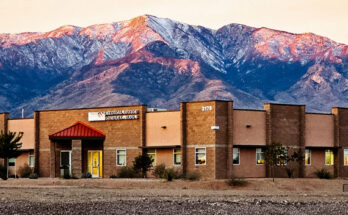Contributed Article By Aimee Staten/Gila County Grants Administrator
GILA COUNTY – Seeing every historic building in south-central Arizona restored and shining with new purpose is the ultimate goal of the Copper Corridor Blight Buster Coalition—and the driving force behind the $600,000 U.S. Environmental Protection Agency (EPA) Assessment Grant that concludes this month.
Made up of communities across Gila and Pinal counties—including Globe, Superior, Miami, Hayden, Kearny, and Winkelman—the Copper Corridor Blight Busters (CCBB) has been battling blight and brownfields for several years. The coalition plans to apply for another EPA grant as soon as federal operations resume.
In October 2021, Gila County received a $600,000 Brownfields Cooperative Assessment Grant from the EPA on behalf of the CCBB. The grant’s purpose was to inventory, characterize, assess, and conduct cleanup planning and community engagement activities for brownfield sites located throughout Gila and Pinal Counties. The funded area included the Superior Opportunity Zone—an area roughly the size of Delaware and one of the largest certified Opportunity Zones in the nation.
Through this funding, Gila County advanced numerous project components, including robust community engagement, the development of a comprehensive brownfields inventory, and the completion of multiple site assessments and studies. Specifically, the project produced 11 Phase I Environmental Site Assessments, 13 Phase II Environmental Site Assessments, seven lead assessment reports, two microbial reports, three Analyses of Brownfields Cleanup Alternatives (ABCA), a solar feasibility study, and a community planning assessment report.
That community planning report—prepared by Evolution Planning & Design LLC under subcontract with Atlas Technologies—will serve as a cornerstone document for Gila County’s forthcoming EPA Brownfields Assessment Grant application. The recent catastrophic flooding of the northern portion of Broad Street in Globe will also figure heavily in the new assessment application to the EPA.
What are Brownfields, anyway?
“Fighting blight and brownfields” sounds noble, but it’s important to understand what those terms mean and why cleanup and redevelopment matter so deeply to our communities.
A brownfield is a vacant, underutilized or abandoned property whose redevelopment or reuse is complicated by the presence—or even the potential presence—of a hazardous substance, pollutant or contaminant.
Many sites in Gila and Pinal counties have tested positive for lead and asbestos contamination, common in older buildings developed before modern safety standards. Others may contain petroleum or other environmental hazards. The assessment and reporting funded through the CCBB grant are the first essential steps toward safe, sustainable redevelopment.
After years of watching once-promising structures deteriorate due to floods, contamination, or lack of investment, some residents may struggle to envision substantive renewal. In the famous words of Mark Twain, however, “The secret of getting ahead is getting started. The secret of getting started is breaking your complex, overwhelming tasks into small, manageable tasks—and starting on the first one.”
Partnerships in Action
Superior Mayor Mila Besich, a CCBB Coalition member who has spearheaded the revitalization of the historic Superior High School, knows firsthand how collaboration can transform a community.
In a town that once faced a vacancy rate nearly as high as New Orleans after Hurricane Katrina, Superior’s leadership knew decisive action was needed to improve both commercial and residential property offerings. Visit www.ccblightbusters.com and watch Superior, Arizona’s Brownfield Journey on YouTube’s CCLRtv channel for a closer look at their progress.
Of the 98 buildings listed on the community’s blight inventory, 35 were demolished, and fewer than 22 remain blighted today, according to Town Manager Todd Pryor. Superior’s battle against blight has been more than a decade in the making, with the CCBB coalition, EPA, and Arizona Department of Environmental Quality (ADEQ) all playing key roles.
The Superior High School, built in 1926 and closed in 1998, was purchased by the town in 2020 to be transformed into a multigenerational community hub. Plans include a senior center, library, town hall, community gym, commercial kitchen, and workforce development facilities.
“Collaborating with Gila County and the Copper Corridor Blight Busters has truly propelled Superior’s economic and community development efforts forward,” Besich said. “Regional collaboration holds immense power—it allows us to share experiences with our sister mining communities and work collectively to solve systemic challenges. Through these efforts, Superior has been able to remedy hazardous, abandoned properties and begin transforming two historic school campuses into vibrant hubs for economic and community growth.”
Another partnership between Gila County and the City of Globe is bringing life back to the Michaelson Building on Broad Street, paving the way for new businesses and jobs. When completed, the building will host Globe’s first co-workspace and business incubator with high-speed Internet connectivity, community meeting rooms, business support resources, and a Downtown visitor’s center.
Built in 1926, the Michaelson Building received a new roof with funding from Freeport-McMoRan and Gila County’s American Rescue Plan Act allocation. The City of Globe and Gila County also each received $150,000 from Resolution Copper to continue renovations. Additional improvements, furnishings and IT equipment will be funded through Gila County, the City of Globe and Congressionally Directed Spending.
Both Superior High School and the Michaelson Building were tested for lead and asbestos by CCBB’s grant contractor, Atlas Technologies. Atlas also evaluated Superior High School for solar photovoltaic (PV) installation and found it to have “tremendous potential for solar energy production,” according to the Solar Feasibility Report.
The Health Haven building was tested for lead, asbestos, and microbial growth, opening the door for a new environmental cleanup grant application by the City of Globe, according to Grants Manager Connie Callaway. “We are looking to provide renewal and service initiatives for seniors in our community,” she said of future plans for the building that was known as the former Gila General Hospital.

Future Plans
Although the Copper Corridor Blight Busters Coalition has made significant strides, much work remains to be done.
Gila County and the CCBB were awarded an Environmental Justice Government-to-Government Grant for just over $1 million, effective January 2025. However, that funding was rescinded by the Trump administration—along with all other Environmental Justice grants nationwide—at the start of 2025.
Despite this setback, local leaders remain undeterred. Even as the federal government remains shut down, Gila County is collaborating with the CCBB Coalition to prepare a new EPA Assessment Grant proposal. The upcoming application will build on the momentum and findings of the recently completed Brownfields Area-Wide Community Planning Assessment, focusing on strategic revitalization and redevelopment across the region.

A key emphasis of the new proposal will be the Broad Street corridor in Globe, which sustained extensive damage during the September and October floods. Targeting this area for environmental assessment and redevelopment will help restore economic vitality and resilience to one of the community’s most visible historic districts.
Gila County Supervisors Tim Humphrey and Woody Cline have voiced their support for continuing the coalition’s work and pursuing every opportunity to bring federal resources into the region. “Any funding that we can reach for that will help our community rebuild will be a blessing,” Humphrey said.
“The funding received from EPA has been an important step in fighting blight in our Copper Corridor communities,” Cline added. “We need to continue moving forward in seeking additional funding to bring more attention and opportunity to our local area.”
Residents and community members can visit www.ccblightbusters.com to view reports from completed projects and learn more about the CCBB’s ongoing efforts to build a cleaner, stronger, and more vibrant Copper Corridor.










